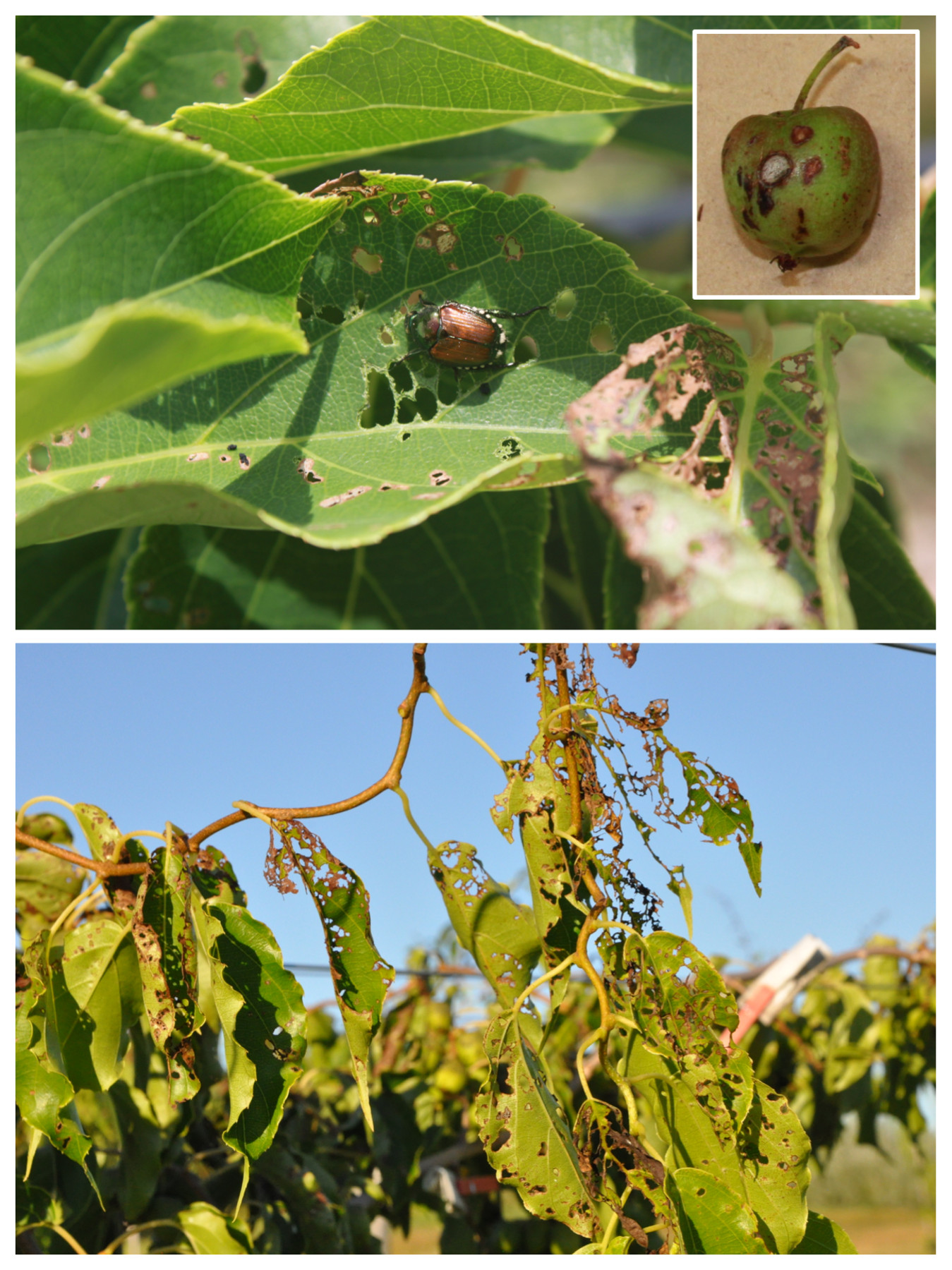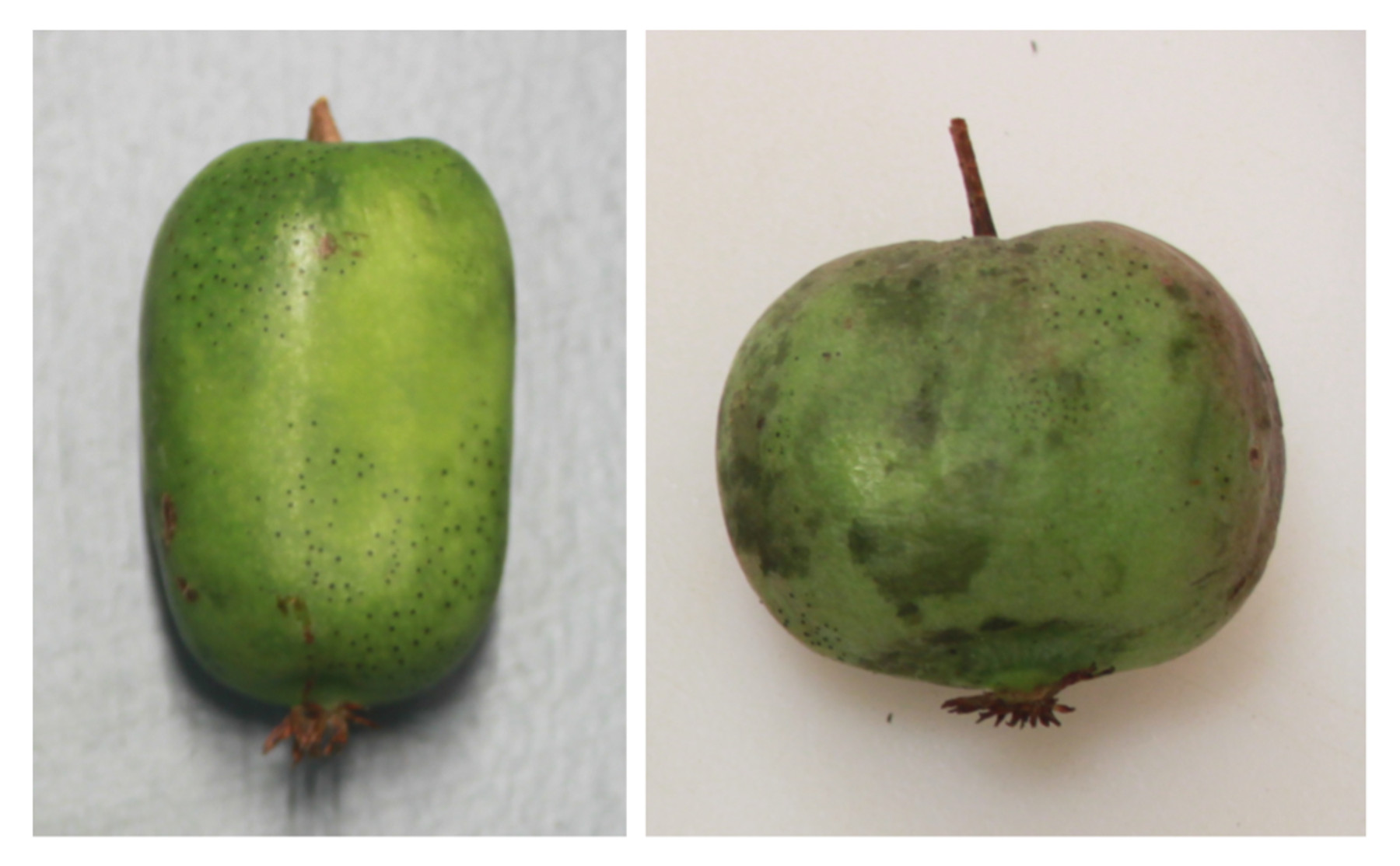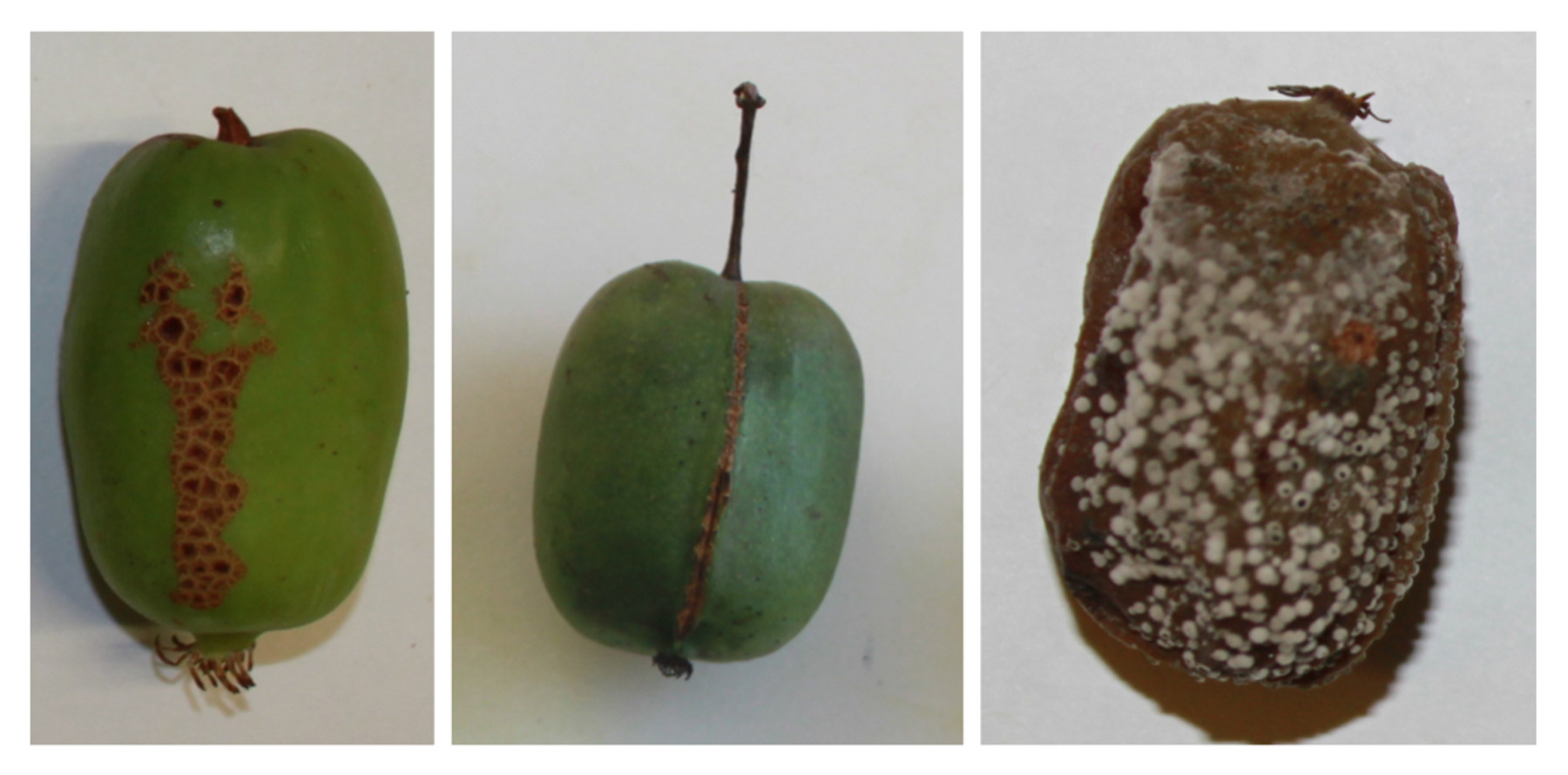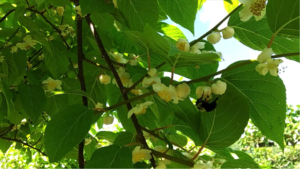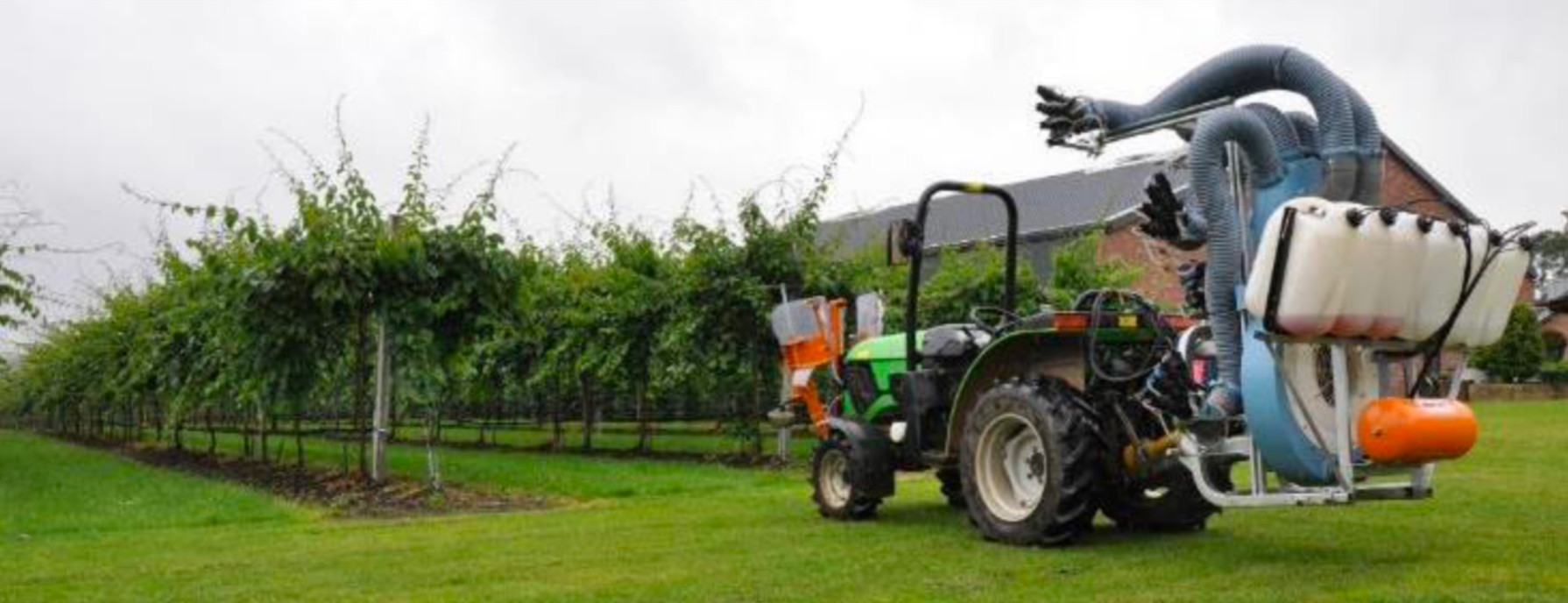Insect Pests & Diseases
In comparison to many other high value horticultural crops grown in the region, kiwiberry appears to have relatively few insect pests and diseases of concern. For this reason, the production of kiwiberries lends itself to low/no spray methods, organic practices, and integrated pest management. As outlined below, the most common insect pests and diseases will be familiar to those with experience producing fruit in New England.
Insect pests
Japanese beetle
Popillia japonica is the most common insect pest observed on the kiwiberry vines at the NHAES. Adults actively feed on foliage and have also been observed feeding on immature berries (Fig 36). As discussed in detail in Vine Management, kiwiberry is a vigorous vine whose vegetation must be intensely managed in a commercial production setting, with 1-2 heavy prunings required during the summer. One upside of such prolific growth is that even extreme foliar feeding by P. japonica has little effect on the productivity of a mature vine.
Immature vines, however, especially in their first or second year, should be protected from high P. japonica pressure. Similar to other stresses (drought, heat, etc.), such feeding can delay both vine maturation and canopy establishment. Also, while foliar feeding damage is unlikely to exceed economic injury levels in older vines, P. japonica population management may be worthwhile in a mature vineyard to reduce cosmetic damage to the berries (Fig 36). Actively feeding adult populations may be managed chemically (using materials which indicate kiwiberry specifically on the label – so far, none) or manually by hand picking individuals in conjunction with an Integrated Pest Management program (Knodel et al., 2012). Weekly scouting and record keeping on emergence date may increase efficacy and reduce the amounts of materials applied.
In addition to standard approaches for controlling P. japonica, one seemingly effective strategy is to make strategic use of kiwiberry vine’s uniquely prolific vegetative growth to draw P. japonica adults away from the fruit-bearing zone of the canopy (D. Jackson, pers. communication). In this approach, now followed at the NHAES, all searcher shoots emerging from the canopy are allowed to grow until P. japonica pressure subsides later in the season. Adult beetles are preferentially drawn to the high, sacrificial shoots, which are then pruned later in the season.
Spotted wing drosophila (SWD)
Although the fruitfly Drosophila suzukii has the potential to be a pest of concern for kiwiberry, the pest appears largely to only target vine-ripened fruits, based on our experiences at the NHAES and those of commercial growers (D. Jackson, pers. communication). If berries are allowed to ripen and soften on vine, however, adult SWD are able to pierce the skin and oviposit their eggs, which can ultimately lead to the presence of SWD larvae feeding internally on the fruit. Fortunately, kiwiberries are climacteric, which means they can be harvested while firm and then ripened off vine (see Harvesting and Postharvest Handling, Storage, and Ripening); thus one can manage the majority of D. suzukii pressure effectively by simple avoidance. If, contrary to recommendations, you opt to ripen the berries on-vine, rapidly cooling fruit to 33℉ immediately after harvest and holding it at that temperature for at least 6 days will kill any SWD eggs or larvae present and arrest further berry deterioration (Kim et al. 2018).
Brown marmorated stinkbug (BMSB)
Based on scouting in production vineyards in central Pennsylvania in recent years (D. Jackson, pers. communication), Halyomorpha halys is a species that is expected to continue to gain ground in the northeast; however, its future relevance as an economic pest of kiwiberry in New England is currently unknown. At the NHAES vineyard to date, stinkbugs have been observed feeding at night on past-peak fruit which had been left on the vine; however, the specific species has yet be confirmed.
Diseases
Current knowledge of pathogens relevant to kiwiberry production in New England is limited. Two pathogens observed in our region and known to negatively impact kiwiberry production in Europe, at times resulting in losses of over 50% due to cosmetic damage, are Schizothyrium pomi (causal organism of flyspeck) and Pelataster fructicola (causal organism of sooty blotch) (Fig 37). Studies have shown that these cosmetic fungal diseases are manageable through chemical controls (McKenna et al. 2012), but currently there are no approved chemicals for use on kiwiberry in New England. It is possible that cultural controls, such as canopy management to improve airflow, may help to reduce instances of these pathogens in kiwiberry; but investigation is required.
In addition to the symptoms associated with flyspeck and sooty blotch, there are several other common cosmetic blemishes of kiwiberries, namely cracking and russeting (Fig 38), which may be the result of pathogens and/or environmental factors. In speaking with growers, theories about the causes of these symptoms abound. One thought is that cracking may be due to wide surface temperature fluctuations during early fruit development that result in micro-fissures that become pronounced as the berries grow. If so, the use of a shade cloth, the application of a protective coating such as kaolin clay, or perhaps a modified pruning technique may potentially reduce such damage. Another theory is that the cracks may be the result of fine scratching of the surface of the ovary by the claws, rakes, or combs of some pollinators. Russeting, on the other hand, is thought by some to result from either mechanical damage (e.g. wind-induced rubbing) or sunscald. It is possible, however, that both cracking and russeting are the result of pathogens instead; and research is certainly needed in this area. In the meantime, what is known is that some varieties are more susceptible to such symptoms than others; thus resistance to cracking and russeting is an important selection criterion in the NHAES breeding program.
Finally, although it is not present in the United States, a serious pathogen of nearly all members of the Actinidia genus is Pseudomonas syringae pv. actinidiae, more commonly referred to as bacterial canker or Psa. This bacterial disease results in shoot dieback and vine death in serious cases, and leaf spotting or flower drop in less serious cases (Everett et al. 2011).
Currently, Psa is present in all major centers of kiwifruit production except for North America. In 2010, the USDA Animal and Plant Health Inspection Service (APHIS) imposed an import ban, such that no Actinidia plant material of any kind may be shipped into the United States without proper phytosanitary documentation and a prolonged period of quarantine (see Appendix 2 ‘Pseudomonas Syringae pv. actinidiae (Psa) Quarantine Language’). Although in general kiwiberry is less susceptible to Psa than fuzzy kiwifruit (Vanneste et al. 2014), the introduction of Psa to the region could be devastating. Don’t be the person who brings Psa into the country!
Other Production Concerns
Extreme temperatures
In temperate fruit-growing regions, including New England, sporadic spring frosts pose a threat to many fruit crops (Rodrigo 2000); and kiwiberries are no exception. Freeze damage can occur once sap begins to flow in late winter and early spring (Strik, 2005; Latocha 2007), harming vulnerable tissue even when concerted effort has been made to select a protected north facing site to delay emergence from dormancy. Damage may occur beginning at 31.1° F, with a 95% mortality in floral buds observed temperatures at or below 26.5° F (Debersaques et al. 2019). Observations at the NHAES suggest that tolerance to frost increases as a vine matures. Certainly young vines in their first few years are the most vulnerable, in that a severe frost can significantly delay vine establishment or even kill a young transplant lacking a well-establishment root system. In central PA, wind machines are used successfully for frost protection in some years (D. Jackson, pers. communication), though their upfront cost may not make sense for small operations.
Alternatively, growers in Europe achieve frost protection in some years with microsprinklers (see Irrigation section for details) or with anti-frost candles. At the NHAES, investigations are underway to determine the roles that air and soil temperatures play in signaling dormancy breaking and whether or not it can be delayed with simple, affordable cultural practices, such as: 1) Applying white latex paint to trunks to maintain cooler trunk temperatures (Litzow & Pellett 1983), and/or 2) Using root collars to drive the root systems deeper in the soil profile, where soil temperatures are less subject to temperature fluctuations. Longer term, the development of superior cultivars with either delayed emergence from dormancy and/or reduced frost sensitivity is a major goal of the NHAES program.
As mentioned in the previous section, excessively warm temperatures during flowering and early fruit development may also pose a risk for some cultivars, in terms of promoting micro-fissures that lead to significant cosmetic damage (cracks). Further studies are needed to understand the role, if any, that temperature plays in this and whether or not its effects can be mitigated via temporary shading, protective coatings such as kaolin clay, or supplemental canopy irrigation.
Crop insurance and kiwiberriesLike any agricultural commodity, kiwiberries are susceptible to the impacts of unpredictable regional weather conditions. Until quite recently, growers wishing to insure their kiwiberry crops from weather-related losses were only able to claim losses for A. deliciosa, or the fuzzy kiwi; a significantly different crop in terms of production, marketing, and grower returns per acre. Typically, crops are insured via the USDA Risk Management Agency; but many specialty and non-commodity crops are not covered. Thanks to the persistent efforts of Dave Jackson and Holly Laubach of Kiwi Berry Organics (Danville, PA), working closely with the Farm Service Agency’s (FSA) Noninsured Crop Disaster Assistance Program (NAP), this gap in insurance coverage has now been filled. It should be noted that any growers wishing to apply for this program must be meticulous in their record keeping, as production records from previous seasons are required for all crop insurance programs. Claim documentation must also include the date and time of the disaster, pictures of damage, and temperatures, if applicable. Additionally, producers are only given a limited amount of time during which they are allowed to file disaster claims. Growers should contact their local FSA office for assistance in applying to the NAP program. |
Wind
Wind is a potential concern for kiwiberry production, as mechanical rubbing may be the underlying cause of the berry scabbing observed at the NHAES and other production sites. Heavy winds may also negatively impact pollinator activity/efficiency, damage growing tips, remove flowers or fruits, and promote desiccation. The use of windbreaks is considered an essential practice in global fuzzy kiwifruit production (McAneney et al. 1984), and it may benefit kiwiberry production as well. As a general rule, windbreaks should be a minimum of 10x longer than they are tall and spaced no more than 10x their height between windbreaks (Brandle & Hodges 2006; see Site Selection section for more information); but for best results, it is recommended to consult some form of windbreak design guide prior to any installation.
Non-insect pests
Kiwiberry vines and fruit are attractive to some mammals which may become pests. Whitetail deer will browse laterals hanging into alleyways and can destroy young vines; thus fencing or some other means of vine protection or population control are recommended. While rodent feeding damage to trunks could be a potential concern during winters with high snow levels, allowing ease of movement without fear of predation, such activity has yet to be observed at the NHAES. In cases where such damage occurs, protective trunk guards may be used to some effect; however, such devices are unable to prevent bark damage by porcupine feeding. While birds are a pest of concern for producers of grapes and many other small fruits and berries in the region, such is not the case for kiwiberry. In agreement with the observations of surveyed growers, no birds have been observed feeding on fruit at the NHAES, despite numerous nests found within the canopies. In general, by harvesting berries while they are still firm (see Harvesting), producers can avoid many potential pest issues.
Cats and kiwiberries?More of an amusement than a pest, another animal drawn to kiwiberry is the domesticated housecat. In 1906, the great plant explorer David Fairchild noticed that a cat that somehow got into his USDA greenhouse went crazy for the kiwiberry vines growing there (Fairchild 1906). Since then, it has been discovered that some members of the Actinidia genus, including kiwiberry, produce a catnip-like compound in their leaves (Bol et al. 2017). In east Asia, in fact, A. macrosperma has long been referred to as the “ginseng of cat” (Zhao et al. 2006) and leaves of A. polygama (a.k.a. silver vine) are commonly used as a feline stimulant. Value-added kiwiberry leaf toys, anyone? |
Pollination
Ensuring adequate pollen supply and distribution within a kiwiberry vineyard is essential to production, not only because cross-pollination (male vine → female vine) is required for fruit set but also because fruit size and symmetry are both positively correlated to seed count (Tiyayon & Strik 2003). The ratio of male to female vines in a vineyard is an important determinant of pollination efficiency, and a minimum of one male for every six female vines is recommended (Strik 2005).
In areas with particularly low pollinator activity, it may make sense to increase the male:female ratio (e.g. to 1:6 or 1:4) (D. Jackson, pers. communication). In at least one extreme case in a European vineyard, males and females were observed to alternate every other row (1:1). Kiwiberry vines are both insect- and wind-pollinated (Strik 2005), and factors such as prevailing wind direction and proximate pollinator habitat should be considered when laying out the vineyard. Alternatively, some growers maintain additional, often unmanaged male vines around the vineyard periphery as a dual-use pollen source and windbreak hedgerow (D. Jackson, pers. communication).
At the NHAES, bumblebees appear to be the primary pollinators (Fig 39). In areas where native pollinator populations are insufficient, however, growers have been known to successfully pollinate their vineyards through the use of imported hives. If managed hives are needed to supplement pollination, you may want to consider a high stocking rate of bumblebees with some supplemental honeybees as a strategy to increase activity via interspecific competition (Sapir & Greenblat 2017). According to rates used by European producers, hives should be stocked at a density of 1.5 – 4.0 hives per acre (Debersaques et al. 2019).
Even if pollinators are present in sufficient numbers, environmental factors such as temperature and rainfall during flowering may limit their efficacy. To mitigate the risk of such events, or to compensate for low pollinator populations, some growers supplement pollination by air-blast spraying fuzzy kiwi pollen, a viable pollination source for kiwiberry (Fig 40). In general, however, a large proportion of the pollen sprayed into the canopy in this way is wasted; and given the high cost of quality, Psa-free pollen (see below), more targeted options have been developed. For example, BioBest offers bumblebee hives with a pollen tray located at the exit of the hive (see Appendix I ‘Grower Resources’). Finally, while hand pollination is not uncommon in kiwifruit production (Huang 2014) and may make sense for a backyard grower with one or two vines, such a practice should not be considered by aspiring commercial producers.
Pollen and bacterial canker diseaseIf purchasing fuzzy kiwi pollen for use in your kiwiberry vineyard, extreme care must be taken to source pollen that is produced in a region certified to be free of bacterial canker disease (Pseudomonas syringae pv. actinidiae; see Insect Pests & Diseases). Although the USDA import ban does not include pollen, there have been documented instances of transferring Psa from fuzzy kiwifruit to kiwiberry via contaminated pollen (Kim et al. 2017). See Appendix I ‘Grower Resources’ for Psa-free pollen suppliers. |
Fig 36 A mature Japanese beetle actively feeding on a kiwiberry leaf (top). Early season feeding damage by Japanese beetles that, although scabbed over, has made the fruit unsellable as Grade A (top inset). Foliar damage resulting from Japanese beetle feeding (bottom).
Fig 37 Cosmetic fly speck (left) and sooty blotch (right) on kiwiberries.
Fig 38 Left to right: Russeting, cracking, and an example of post-harvest soft rot on kiwiberries.
Fig 39 Bumblebees are frequently observed pollinating the kiwiberry vines at the NHAES. The vine pictured here is not A. arguta but rather A. polygama, another cold-hardy kiwi species.
Fig 40 A large-scale vineyard sprayer prepares to apply supplemental pollen to a European kiwiberry vineyard. Photo credit: Management Strategies for a Productive Kiwiberry Orchard (Debersaques 2017)

